So this won’t be a traditional review from us. EK who have been a generous sponsor of the site were unable to sponsor us this time with the Predator AIO cooler. If you are interested in *real* unbiased testing in an accurate way then please let EK (facebook, twitter) know that you’d like us to actually get one on the bench.
However despite not having a predator, we have reviewed a fair amount of the components here including the Supremacy MX, the EK Vardar and the EK PE radiator. So let’s combine that info as best we can to theorize how it might perform. The predator also includes a low power DDC (6W) (the regular DDC 3.2 is 18W). It should be noted that Swiftech’s AIO also uses a detuned DDC running at 6W.
The Predator comes in two sizes – the 240 without the QDC and a 360 which comes with a QDC In order to add a GPU. This is pretty cool.
While you might expect EK to use their new slimmer narrower SE that we recently reviewed instead it uses the PE radiator for an overall thickness of 68mm. The slimmer SE wouldn’t help because the pump is really dictating the thickness here. Needless to say this means that it will not fit in the tightest of cases:
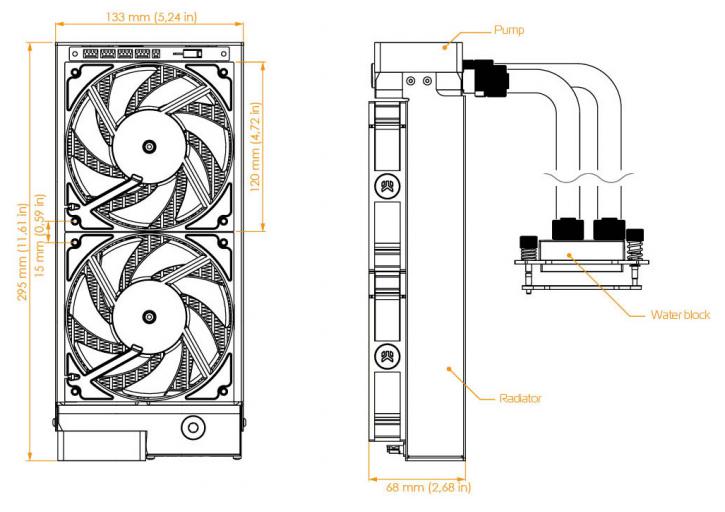
In addition the predator also builds in some PWM control for pump and fans (Credit for these following images goes to Guru3D.com):
There are 4 PWM outputs of which three are used here – 2 fans and 1 pump. There are also two other 2 pin headers – one for power – an adapter connects to a sata header (shown below). EK also saw fit to include an LED on the small circuit board here to show if power is there. The other header is a PWM/Tach wire to the motherboard. So far so good.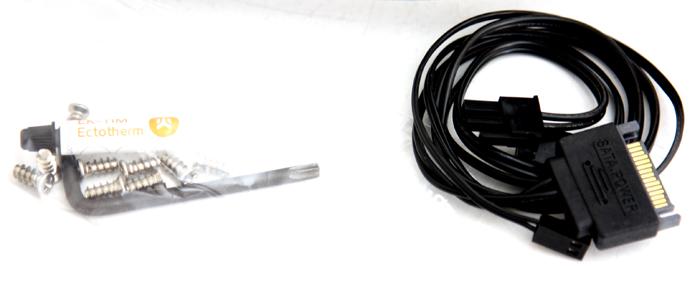
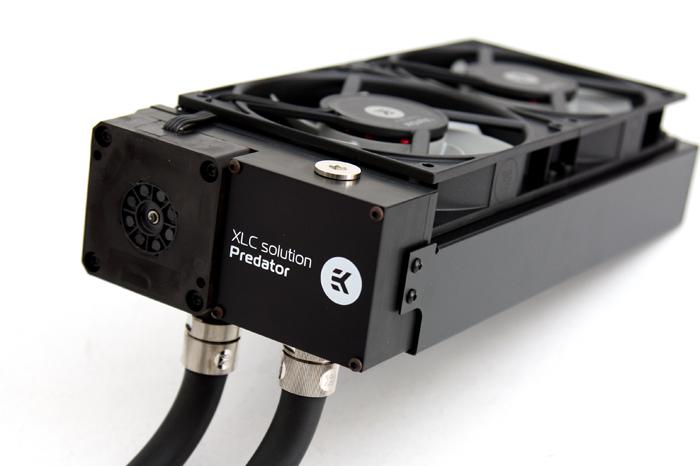 There are also some extra ports on the Predator – one on the pump end, and one on the far end that you can see next to the PWM headers (three pics up). This makes it easy for EK (and you) to fill and drain the system without disconnecting the tubes.
There are also some extra ports on the Predator – one on the pump end, and one on the far end that you can see next to the PWM headers (three pics up). This makes it easy for EK (and you) to fill and drain the system without disconnecting the tubes.
So at first glance we have a compactish AIO that combines the great MX block, the decent PE radiator, the decent Vardar fans and a great DDC pump. Let’s take a second and compare it to “the main competition”. Afterall while some users will cross shop this to regular AIOs such as Corsair’s H100i the closest thing is really Swiftech’s H220X:
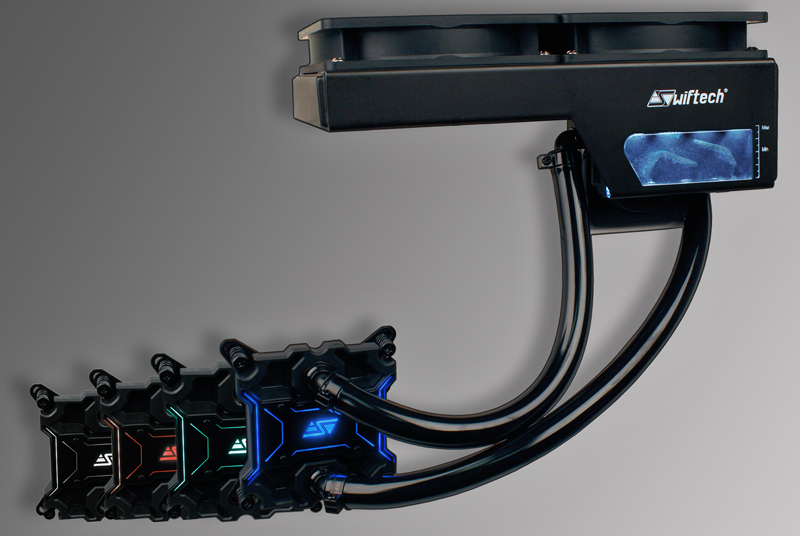
The swiftech unit is very efficient in terms of space around the radiator – almost no overhang vs the fans. The radiator is also more slim which may make it more compatible with cases. The downside of course is the reservoir and pump sticking out below the radiator. This could cause a compatability issue, but if anything it is a feature to me. A reservoir helps to bleed a loop. It can trap air rather than allowing air to get trapped elsewhere in the loop. For the EK system there is no real reservoir, and certainly there is no visual indication of air build up. This means no indication of small slow leaks and a harder life if you ever want to refill it.
In return however the EK should provide better performance. Let’s take a look at some of the parts that we have reviewed – first up the MX block:

While it’s not the highest performing block that we’ve tested it’s certainly very close (1C). The Swiftech block however did not do so well:

The best orientation of the XL was 2C behind the leading block on a CPU that had much lower power consumption. We’ll be retesting both soon on X99 for a real head to head comparison.
Let’s also look at our PE results for 1850RPM push fans:
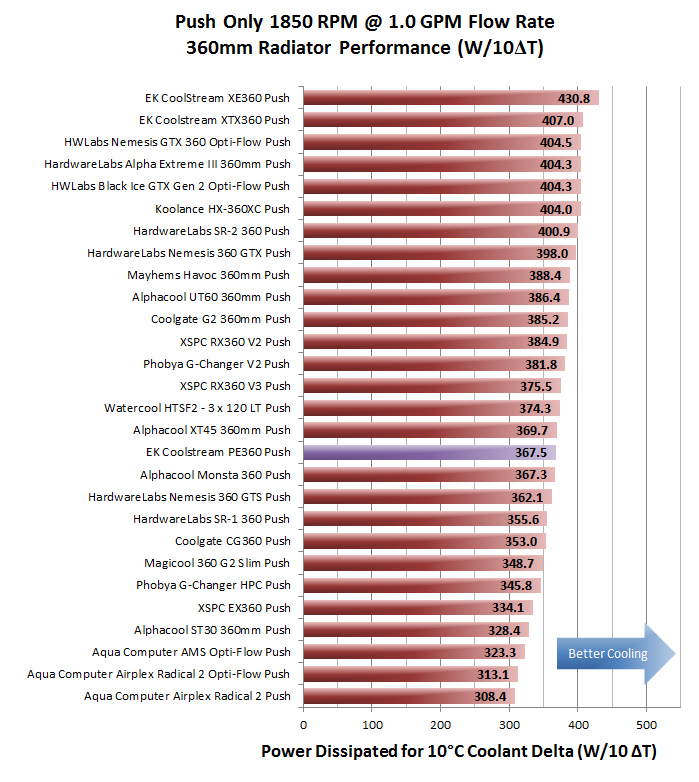
Here the PE is clearly not the best radiator – but it’s also not the thickest. For it’s thickness it is in fact doing quite well. In fact none of the slim radiators manage to beat it.
Lastly let’s consider the compression fittings. EK’s compression fittings are quite nice. They give good grip on the tube and on the lockring when tightening them down. They are also sized to work well with EK’s plasticizier free “ZMT” tube which uses Norpene. We also like this tube, it has an industrial feel to it, but is quite sleek in it’s own way while being quite foolproof. The QDC is another story – we haven’t tested it, but it’s mismatched colors and plastic look coupled with the use of barb/clamp screams of cost cutting on an otherwise premium product. We criticize Swiftech for the uses of barbs/clamps on their AIO and so EK is subject to the same based on the QDC.
Lastly let’s take a look at the Vardar results:
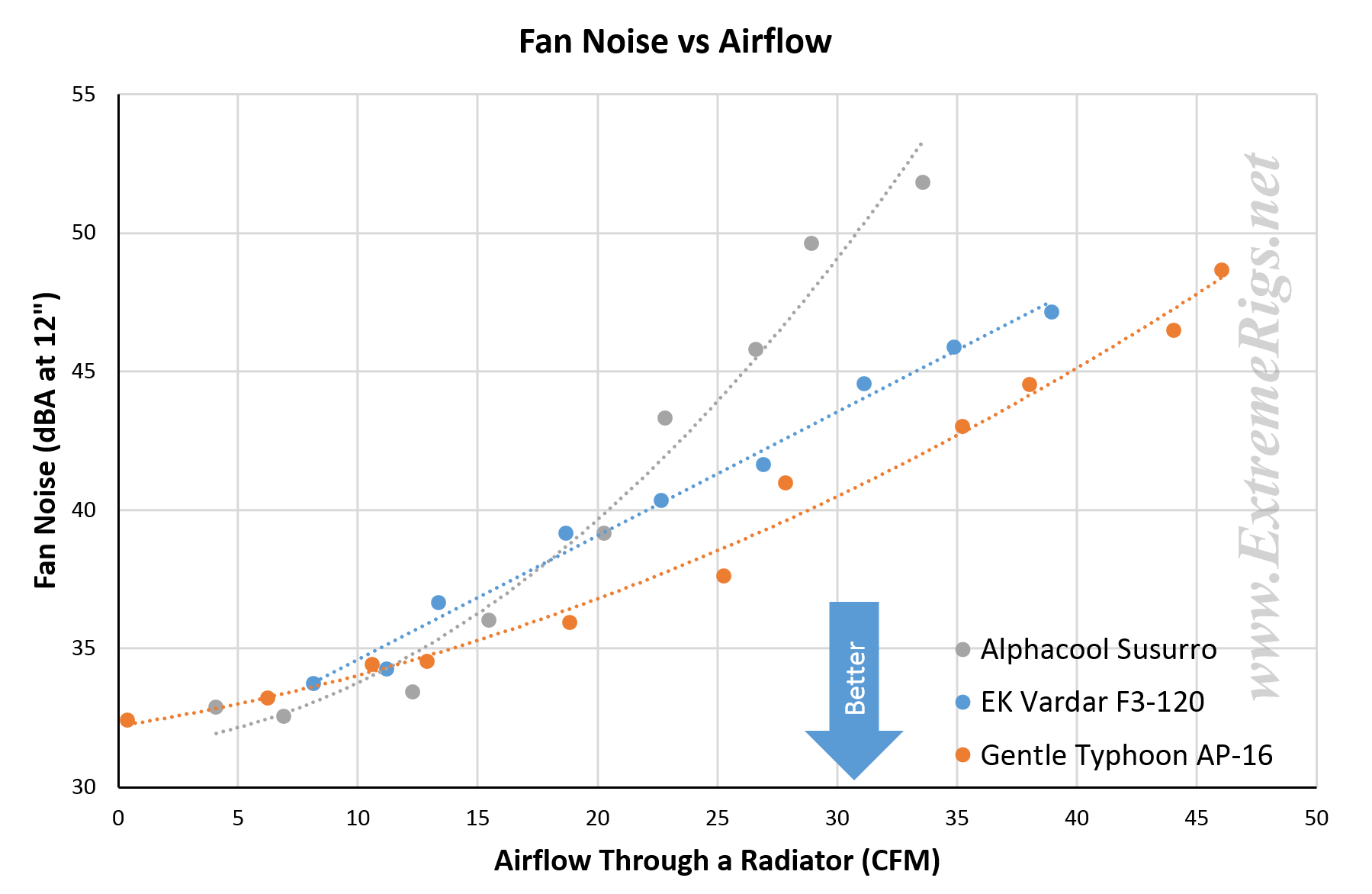
We suspect that the Vardar results are similar to Swiftech’s fans which are also based closely on the Gentle Typhoon design.
The pumps we also suspect are essentially the same as they are both 6W DDC variants.
So performance overall of the EK vs the Swiftech will be comprised of:
- Better CPU block (MX vs Apogee XL)
- Better radiator (PE 240 vs slim narrow 240)
- Similar fan performance (Both GT variations that aren’t quite as good)
- Similar for the pump (Both 6W DDCs)
And the price?
$200 for the EK vs $140 for the Swiftech. Yes that’s right the EK AIO in a 240 size is $200. Bear in mind EK’s own 240 kit with a real DDC and a real reservoir is currently $225 (I think this was $210 only last week too):
For 10% more money you get more pump power and a real reservoir. You even get a PWM splitter, additional fittings and a PSU jumper so the only thing you lose out on is the LED to show that everything is powered properly.
So let’s take a look at the results from the bigger sites who did get their hands on a predator. We’ll skip some of the less interesting stuff like idle tests and load without an overclock. If we sound critical of these tests it’s simply because to take good data requires a lot of attention to detail and data logging time. Just look at our radiator round up for how hard it is to accurately measure air temperature into a radiator. The reality is that the mainstream review sites simply don’t have time to delve into the details as much as we do. They take far less time to do a review and that’s ok, but for you the reader we point it out so you know how much to read into the data. Hopefully you’ll see why we do what we do and understand the data presented below in the context of their margins of error.
Guru3D loaded their CPU for <10 minutes and chose to record the maximum core temperature rather than an average. In that short period of time the system may not have had a chance to equalize and without averaging it will be quite sensitive to ambient shifts like AC kicking in and out. The radiator therefore is not really being tested as much as the CPU block coupled with coolant capacity. There were no mention of multiple block mounts to ensure that there wasn’t a bad mount so you have to factor that error in as well. The margin of error we would estimate on this result at +/-3 degrees. Here are their overclocked results from the 4790K (courtesy of Guru3d.com):
A decent result – but bear in mind each cooler is presumably running at max fan rpm – without factoring in noise this is kind of worthless. Luckily they also measured the noise under load:
These numbers were measured from 75cm away, which is a bit too far for precise measurements, but it’s worth noting that the H110iGT measured the same.
Now let’s look at TechPowerUp’s review – more interestingly they had a Swiftech AIO to compare with. TPU at least gave the system 15 minutes of load and then reported the maximum temperature from their measurements. A better test methodology given that it was over a longer period of time, but hardly that accurate still. Again we’d still estimate this at about +/-2.5 degrees of accuracy – again credit for all data/plots here to TechPowerUp:

Essentially a tie between EK and Swiftech here, and TPU can’t tell the difference between a 280 rad and a 240 rad for the Swiftech. It should be noted that Swiftech’s fans were measured quieter, presumably because of a lower RPM:

LegitReviews did use averaging of the core temperatures but again only over a period of 15 minutes with no mention of a warmup, nor multiple mounts:
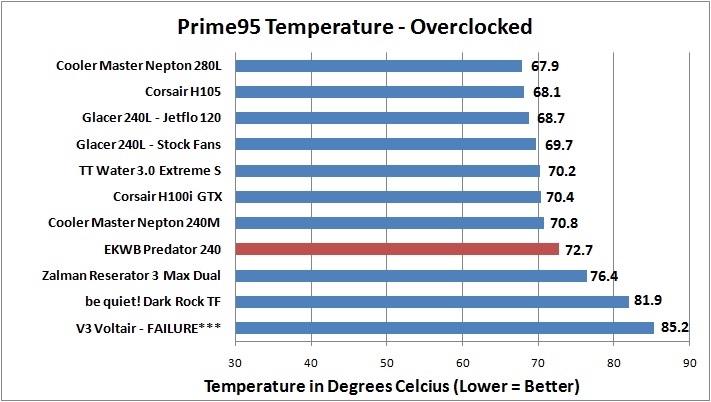
This is by far the best methodology of the three. Here we’d estimate maybe +/-2 degrees of accuracy. Again this is a result that makes some of the AIO’s with high speed fans seem to punch above their weight. With equal fans I can’t imagine how the H100i with a thin radiator, weak block and pump could really beat out the Predator. Bear in mind the H105 has 2700RPM fans for example.
So what does this mean?
- Mainstream reviewers failed to notice a significant thermal performance difference between the $200 Predator and the $140 H220X.
- If you don’t care about your ears then cheaper AIO units like the H105 are in the same ballpark of performance
Summary – Overpriced
The EK Predator is a nice product – it seems to be high quality and a great first step into the world of water cooling for those who aren’t ready to commit. However despite all the good stuff there are some weak points.
The Supremacy MX’s mount for mainstream CPUs is simply not noob friendly. AMD CPU’s are not supported out of the box. The QDC in the 360 kit is also a bit ugly and out of character with the rest of the kit. However the single biggest problem is the price.
For $60 less you get the Swiftech AIO which also can be upgraded in a similar fashion to the EK. The Swiftech has the built in reservoir and lighting. However the real bargain here is EK’s own L240 kit. For $25 more you get a real cylinder reservoir and a real full power pump. This is a kit that will perform just as well but is far better value. If you’re new to the world of watercooling and thinking of buying the predator as a first step I’d suggest skipping straight to the L240 kit, if you’re on a budget then stick with the Swiftech.
Where to buy: PPCs – Predator 240 – $200, Predator 360 – $240








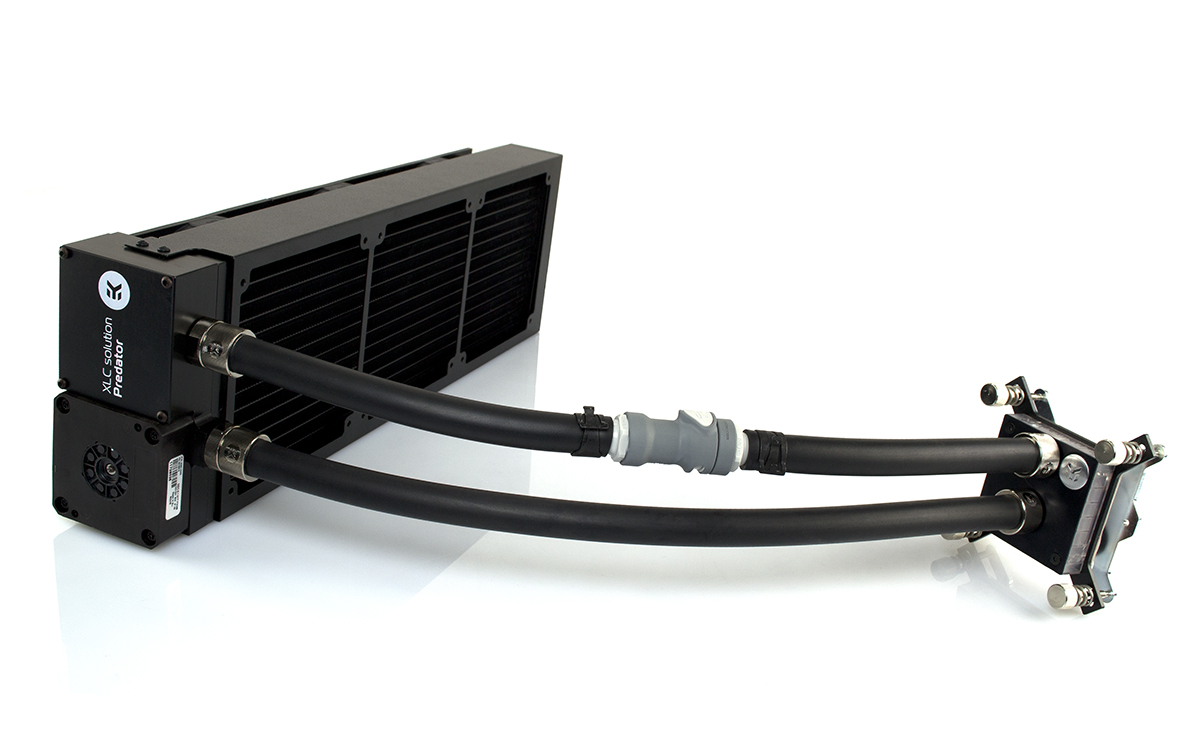
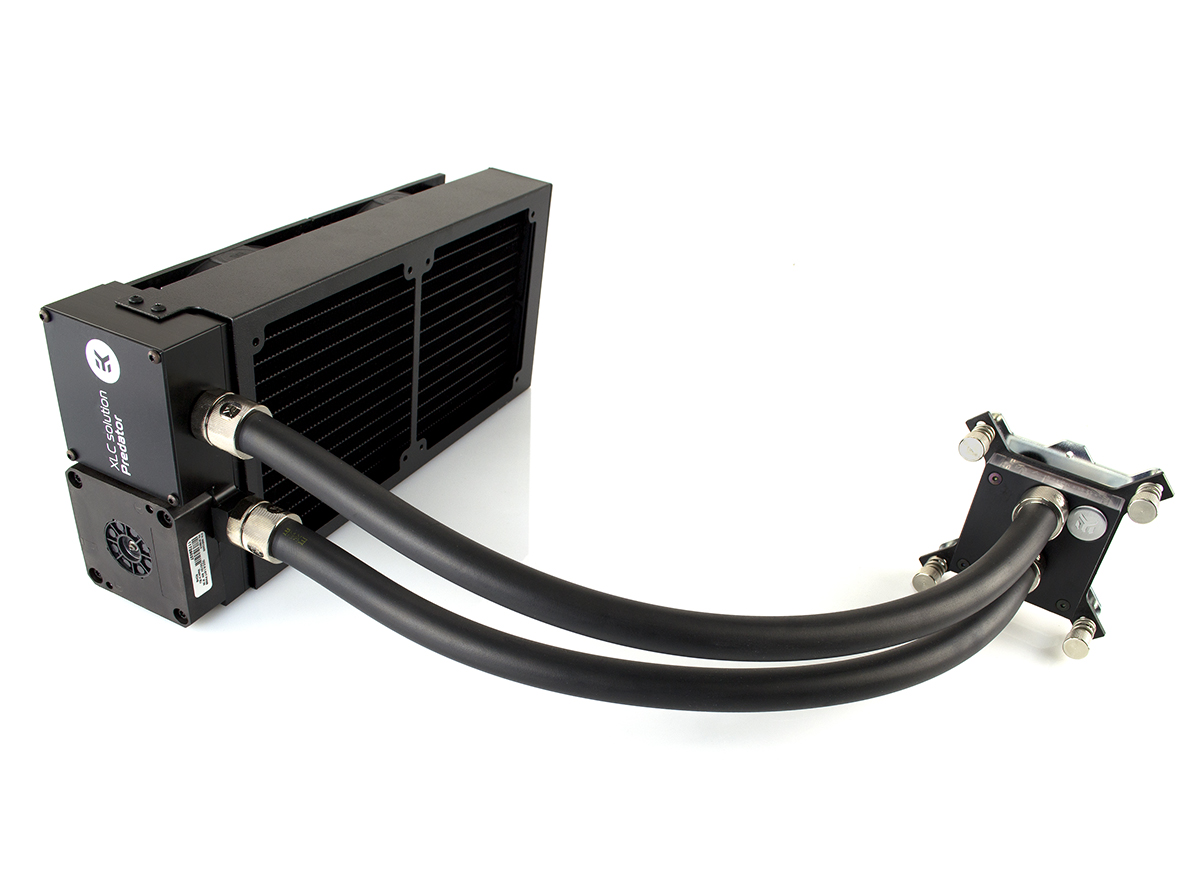
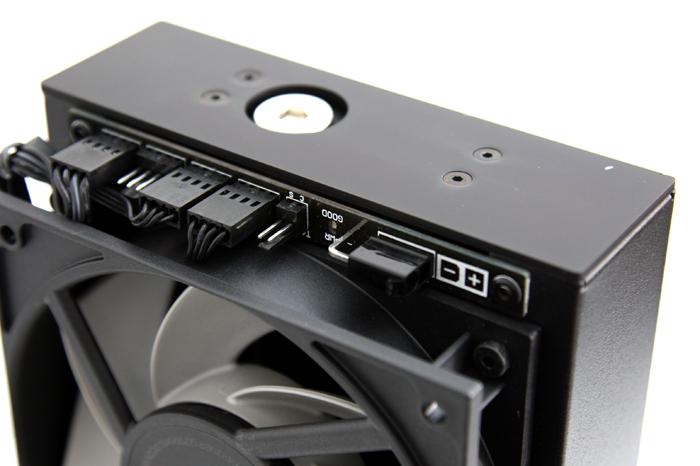
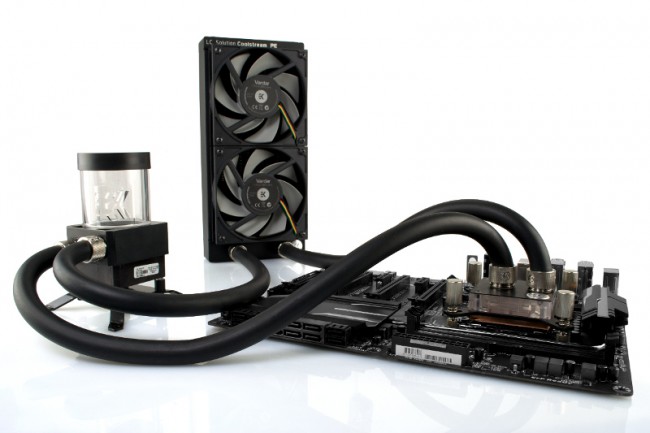



Payback snubbing against Extreme Rigs by EK for coverage of the XE Series rad issues?
Looking at the L240 on the EK site, it is listed with the same rating pump at 6W, not a full 18w… Just wanted to clarify that. I do think that the kit is the better deal here, and offers more compatibility. However, some people just want to bolt something on and are intimidated by a kit.
Comments are closed.